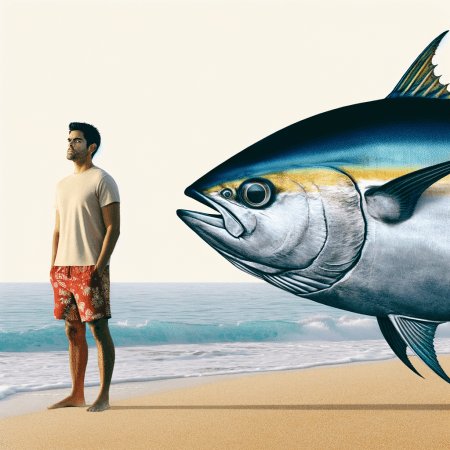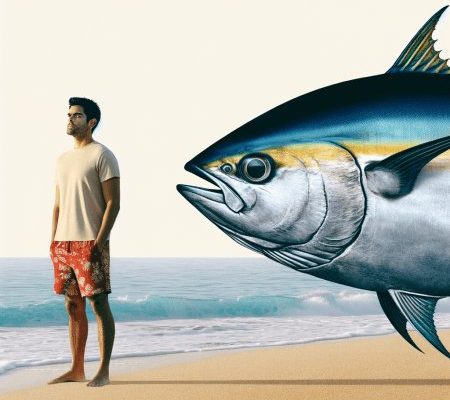
Imagine standing on the edge of a boat, looking down into the azure waters where tuna dart past like underwater torpedoes. Engaging with these fish is a bit like trying to approach a wild horse; they’re beautiful but need to be respected from a distance. So, in this article, we’ll dive into how we can safely interact with tuna, the various types of tuna we encounter, and the best practices to follow for a fulfilling and responsible experience.
Understanding Tuna Species
There are several species of tuna, each with its own characteristics and habitats. The most recognized types include:
- Bluefin Tuna: These giants can weigh over 1,000 pounds and are prized for their taste. They often inhabit the deeper parts of the ocean.
- Yellowfin Tuna: Slightly smaller than bluefin, yellowfin are known for their vibrant yellow finlets and are commonly found in warmer waters.
- Bigeye Tuna: These are similar to yellowfin but are generally larger and can dive deeper into the ocean.
- Albacore Tuna: Often marketed as canned tuna, albacore is smaller and has a milder flavor. They’re great for fishing enthusiasts.
You might be wondering why understanding these species is important. Each type of tuna has its behavior and habitats, which can affect how we interact with them. For example, bluefin are typically more elusive, making encounters rare compared to the more social yellowfin.
The Importance of Respectful Interaction
When interacting with tuna, respect is key. These fish are wild animals, and maintaining a safe distance is crucial for both your safety and theirs. Approaching tuna too closely can introduce stress to the fish and disrupt their natural habits.
Here’s the thing: if you’re scuba diving or snorkeling, try to observe from afar. Use a camera with a zoom lens to capture those breathtaking moments without intruding on their space. If you’re fishing, practice catch and release to help maintain their population.
Doing your research before heading into the water helps you understand tuna behavior, which can lead to more respectful and safe interactions. Remember, we’re guests in their world.
Best Practices for Tuna Interactions
Want to ensure your encounters with tuna are safe and enjoyable? Here are some best practices to follow:
- Maintain Distance: Always keep a respectful distance—about 10 to 15 feet—when watching tuna. This will help prevent stressing them out.
- Use Equipment Wisely: If you’re snorkeling or diving, make sure your gear is eco-friendly and doesn’t harm the environment.
- Educate Yourself: Understanding tuna’s migratory patterns and feeding habits can help you spot them more effectively.
- Follow Local Regulations: Always be aware of fishing rules and guidelines in your area, as they exist to protect both the fish and the ecosystem.
By following these simple tips, you can enjoy your time with tuna while helping preserve their natural behaviors and habitats. It’s all about being conscious of their needs as much as your own.
Where to Safely Interact with Tuna
If you’re eager to see tuna up close, there are several places around the world that offer safe interaction opportunities. Here are a few notable spots:
- The Mediterranean Sea: Known for its thriving bluefin tuna population, many tours allow for high-seas excursions.
- The Caribbean: The warm waters are great for yellowfin encounters, often during fishing expeditions or underwater tours.
- California and Hawaii: These regions are famous for their bigeye tuna, making them popular spots for both fishing and diving experiences.
Each of these locations offers different experiences, from fishing charters to snorkeling tours. Just make sure to book with responsible operators who prioritize sustainable practices.
The Role of Tuna in the Ecosystem
Tuna are not just fish—they’re key players in marine ecosystems. As predators, they help maintain the balance of ocean life. They prey on smaller fish and contribute to controlling their populations, which in turn supports healthier marine habitats.
Here’s a thought: by interacting respectfully with tuna, you’re not only enjoying an incredible experience but also fostering a greater understanding of our ocean’s delicate balance. This knowledge can empower you and others to advocate for ocean conservation and sustainable fishing practices.
Risks of Interacting with Tuna
While tuna can be awe-inspiring, there are risks involved in interacting with them. Some potential risks include:
- Human Safety: Tuna can be swift and powerful. If you’re in a small boat or near a fishing line, be cautious, as they can inadvertently cause accidents.
- Environmental Impact: Overfishing and habitat destruction threaten tuna populations. It’s vital to engage in sustainable practices.
- Disturbing Natural Behavior: Getting too close can stress tuna, leading to them changing their feeding and migratory habits.
Being informed about these risks helps you approach tuna interactions with the right mindset. After all, safety is priority number one.
Closing Thoughts
In conclusion, interacting with tuna can be a thrilling experience if done thoughtfully and respectfully. By understanding their species, maintaining a safe distance, and following best practices, you can enjoy the wonder of these magnificent fish without interfering with their natural lives.
So next time you’re near the ocean, consider taking a moment to appreciate the beauty of tuna. Remember, these fish are more than just a catch; they’re essential members of a complex marine ecosystem. With responsible practices, we can all enjoy the ocean’s bounty while ensuring it remains vibrant for future generations.

